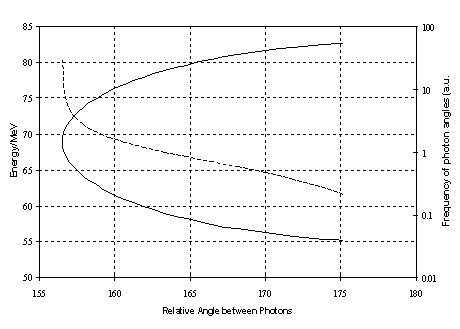 .
.





 .
.For RC one obtains the energies E( g ) = 129.404 MeV and Ekin(n) = 8.8695 MeV. For SCX the neutron has no more than 0.4183 MeV kinetic energy while the p 0 has a total energy of E( p 0) = 137.8562 MeV. The p 0 with a velocity b of 0.20333 instantaneously decays into 2 photons. The photon energy has to be calculated in the laboratory frame using
 ,
,where f p 0 is the angle between the p 0-direction and a fixed z-axis. Since the probability for each angle f p 0 is equal because pions are spinless, this results in a box distribution with photon energies between 54.91 MeV and 82.94 MeV. When both photons share the same energy E p 0/2=68.928 MeV they have the lowest possible opening angle of f g g ,min=156.537° as seen in Figure 6-4. Since the differential solid angle d W =-2 p d(cos( f )) is proportional to the number of emitted particles the frequency of emitting angles can be computed using dcos( f )/dcos( f ')=sin( f ')/(d f '/d f ), where f is the angle of the neutral pion with respect to the z-axis and f ' the relative angle of the two photons. f ' and f are related using the kinematic formulas for emitting angles of the individual photons, hence
 .
.

Since the photon energies of the two reactions of interest are well separated, one can clearly distinguish SCX and RC with an electromagnetic calorimeter of high energy resolution. The counts under the p 0 distribution divided by the counts under the RC peak then will give twice the Panofsky ratio (since the probability for detecting one of the two photons from p 0-decay is twice as large as for a single photon from RC).





